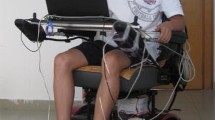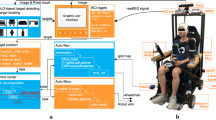Abstract
Currently, electric wheelchairs are commonly used to improve mobility in disabled people. In severe cases, the user is unable to control the wheelchair by themselves because his/her motor functions are disabled. To restore mobility function, a brain-controlled wheelchair (BCW) would be a promising system that would allow the patient to control the wheelchair by their thoughts. P300 is a reliable brain electrical signal, a component of visual event-related potentials (ERPs), that could be used for interpreting user commands. This research aimed to propose a prototype BCW to allowed severe motor disabled patients to practically control a wheelchair for use in their home environment. The users were able to select from 9 possible destination commands in the automatic mode and from 4 directional commands (forward, backward, turn left and right) in the shared-control mode. These commands were selected via the designed P300 processing system. The wheelchair was steered to the desired location by the implemented navigation system. Safety of the user was ensured during wheelchair navigation due to the included obstacle detection and avoidance features. A combination of P300 and EOG was used as a hybrid BCW system. The user could fully operate the system such as enabling P300 detection system, mode shifting and stop/cancelation command by performing a different consecutive blinks to generate eye blinking patterns. The results revealed that the prototype BCW could be operated in either of the proposed modes. With the new design of the LED-based P300 stimulator, the average accuracies of the P300 detection algorithm in the shared-control and automatic modes were 95.31 and 83.42% with 3.09 and 3.79 bits/min, respectively. The P300 classification error was acceptable, as the user could cancel an incorrect command by blinking 2 times. Moreover, the proposed navigation system had a flexible design that could be interfaced with other assistive technologies. This research developed 3 alternative input modules: an eye tracker module and chin and hand controller modules. The user could select the most suitable assistive technology based on his/her level of disability. Other existing assistive technologies could also be connected to the proposed system in the future using the same protocol.


























Similar content being viewed by others
References
Anton P, Lee S, Aharon W, Roni K, Lior H, Yaara Y, Nachum S, Noam S (2010) Sniffing enables communication and environmental control for the severely disabled. Proc Natl Acad Sci 107:14413–14418
Arai K, Ronny M (2011) Eyes based eletric wheel chair control system. Int J Adv Comput Sci Appl 12:98–105
Brice R, Etienne B, Cuntai G, Haihong Z, Chee L T, Qiang Z, Marcelo A, Christian L (2006) A brain controlled wheelchair based on P300 and path guidance. In: Biomechatron (Biorob), pp 1001–1006
Brice R, Etienne B, Cuntai G, Haihong Z (2010) A brain controlled wheelchair to navigate in familiar environments. Neural Syst Rehabil Eng 18:590–598
Christian M, Thorsten L, Tim L, Thomas R, Axel G, Bernd KB (2009) Navigating a smart wheelchair with a brain-computer interface interpreting steady-state visual evoked potentials. In: Intelligent robots and systems, pp 1118–1125
Dilok P, Yodchanan W (2011) Illuminant effect on LCD and LED stimulators for P300-based brain-controlled wheelchair. In: Biomedical engineering international conference (BMEiCON), pp 254257
Dilok P, Yodchanan W (2012) Semi-automatic P300-based brain-controlled wheelchair. In: Complex medical engineering (CME), pp 455–460
Dilok P, Sarawin K, Pongsakom W, Boonyanuch W, Yodchanan W (2014) Automated navigation system for eye-based wheelchair controls. In: Biomedical engineering international conference (BMEiCON)
Duan J, Li Z, Yang C, Xu P (2014) Shared control of a brainactuated intelligent wheelchair. In: 11th world congress on intelligent control and automation (WCICA), pp 341–346
Farwell LA, Donchin E (1988) Talking off the top of your head: toward a mental prosthesis utilizing event-related brain potentials. Electroencephalogr Clin Neurophysiol 70:510–523
Gautam G (2014) Eye movement based electronic wheel chair for physically challenged persons. Int J Sci Technol Res 3:206–212
Gray L, Galetta SL, Siegal T, Schatz N (1997) The central visual field in homonymous hemianopia. Arch Neurol 54:312–317
Gwang ME, Kyeong K, Chul SK, James L, Soon CC, Bongsoo L, Hiroki H, Norio F, Ryoko F, Takashi W (2007) Gyro-mouse for the disabled: ‘Click’ and ‘position’ control of the mouse cursor. Int J Control Autom Syst 5:147–154
Horacio AB, Shir BZ, Shlomo B, Marta K (2011) Parafoveal perception during sentence reading?: an ERP paradigm using rapid serial visual presentation (RSVP) with flankers. Psychophysiology 48:523–531
Hugh H (2009) Exoskeletons and orthoses: classification, design challenges and future directions. Neuroeng Rehabil 6:2387–2396
Hugh DW, Tim B (2006a) Simultaneous localization and mapping: part I”. Robot Autom Mag 13:99–110
Hugh DW, Tim B (2006b) Hugh DW, Tim B (2006) Simultaneous localization and mapping (SLAM): part II”. IEEE Robot Autom Mag 13:108–117
Inaki I, Javier MA, Andrea K, Javier M (2009) Non-invasive brain-actuated wheelchair based on a P300 neurophysiological protocol and automated navigation. IEEE Trans Robot 25:614–627
Jeonghee K, Hangue P, Joy B et al (2013) The tongue enables computer and wheelchair control for people with spinal cord injury. Sci Transl Med 5:213
Johan P, Jose del RM, Gerolf V, Eileen L, Ferran G, Pierre WF, Hendrik VB, Mamix N (2007) Adaptive shared control of a brain-actuated simulated wheelchair. In: Rehabilitation robotics
John C, Lynne S, Jayme K (2008) Neuromuscular electrical stimulation for motor restoration in hemiplegia. Topics Stroke Rehabil 15:412–426
Jonathan RW, Niels B, Dennis JM, Gert P, Theresa MV (2002) Brain-computerinterfaces for communication and control. Clin Neurophysiol 113:767–791
Karl L, Kaitlin C, Alexander D, Kaleb S (2013) Quadcopter control in three-dimensional space using a noninvasive motor imagery-based brain–computer interface. J Neural Eng 10:4
Kazuo T, Kazuyuki M, Hua OW (2005) Electroencephalogram-based control of an electric wheelchair. Robotics 21:762–766
Krzysztof D, Piotr W (2015) Brain-computer interface for mobile devices. J Med Inf Technol 24
Kyuwan C, Andrzej C (2008) Control of a wheelchair by motor imagery in real time. In: Intelligent data engineering and automated learning, pp 330–337
Miami B (2009) Feature extraction and classification of EEG signals for rapid P300 mind spelling. In: International conference on machine learning and applications
Michael J, Kevin G, John A, Ruth F (2008) A sip-and-puff wireless remote control for the Apple iPod. Assist Technol 20:107–110
Morgan Q, Brian G, Ken C, Josh F, Tully F, Jeremy L, Eric B, Rob W, Andrew N (2009) ROS: an open-source Robot Operating System. In: ICRA workshop on open source software
Ng DW-K, Soh Y-W, Goh S-Y (2014) Development of an autonomous BCI wheelchair. In: IEEE symposium computational intelligence brain computer interfaces, pp 1–4
Rossella B, Simone C, Bernardo DS, Giulio F, Matteo M, Davide M (2008) Brain control of a smart wheelchair. Intell Auton Syst 10:221–228
Stefan K, Johannes M, Thorsten G, Karen P, Uwe K, Oskar S (2013) Hector open source modules for autonomous mapping and navigation with rescue robots. In: RoboCup 2013: Robot World Cup XVII, pp 624–631
Susumu H, James AL, Jonathan M, Xiao L, Jeff AB (2006) The vocal joystick: evaluation of voice based cursor control techniques. In: ASSETS, pp 197–204
Torsten F, Rainer N (2007) Nordmann alternative wheelchair control. In: Proc RAT’07, pp 67–74
Tyler S, Colin B, Michel JAG, Arthur P (2008) Tooth-click control of a hands-free computer interface”. IEEE Trans Biomed 55:2050–2056
Ulrich H, Jean-M V, Touradj E, Karin D (2008) An efficient P300-based brain–computer interface for disabled subjects. J Neurosci Methods 167:115–125
Varona-Moya S, Velasco-Álvarez F, Sancha-Ros S, Fernández-Rodríguez Á, Blanca MJ, Ron-Angevin R (2015) Wheelchair navigation with an audio-cued, two-class motor imagery-based brain—computer interface system. In: 7th international IEEE/EMBS conference on neural engineering (NER), pp 22–24
Yunyong P, Yodchanan W (2010) Hybrid EEG-EOG brain-computer interface system for practical machine control. In: EMBC
Yunyong P, Yodchanan W (2012) Minimal-assisted SSVEP-based brain-computer interface device. In: APSIPA ASC, pp 1–4
Zhang R et al (2015) Control of a wheelchair in an indoor environment based on a brain-computer interface and automated navigation. IEEE Trans Neural Syst Rehabil Eng 24:128–139
Acknowledgements
This projected was supported by the National Research Council of Thailand (NRCT). The development of the EEG acquisition system was supported by the National Broadcasting and Telecommunication Commission (NBCT). Finally, many thanks go to all of the disable subjects from Putthamonthon Independent Living Center (PILC) and the healthy subjects who volunteered to participate in the experiments described in this paper.
Author information
Authors and Affiliations
Corresponding author
Rights and permissions
About this article
Cite this article
Puanhvuan, D., Khemmachotikun, S., Wechakarn, P. et al. Navigation-synchronized multimodal control wheelchair from brain to alternative assistive technologies for persons with severe disabilities. Cogn Neurodyn 11, 117–134 (2017). https://doi.org/10.1007/s11571-017-9424-6
Received:
Revised:
Accepted:
Published:
Issue Date:
DOI: https://doi.org/10.1007/s11571-017-9424-6




